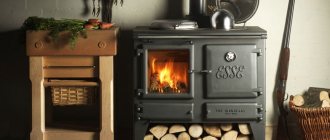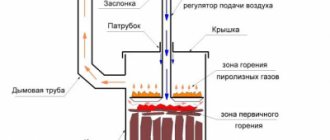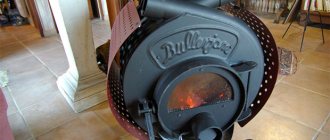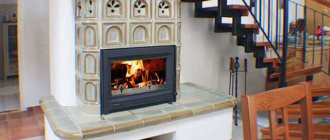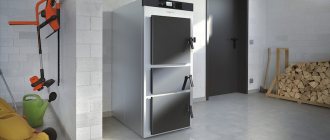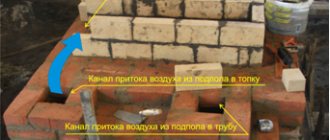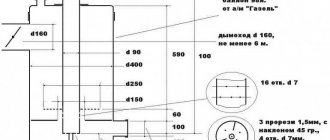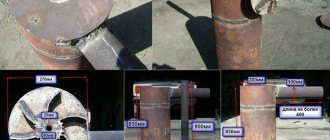Heating a country house and cottage during the cold season is one of the most pressing problems for any owner.
wood stove option for a summer house
Long-burning wood-burning stoves and fireplaces for summer cottages allow you to do this efficiently and economically. And the fact that you can fold them with your own hands makes this design one of the most popular among homeowners.
In this article we will describe in detail step-by-step instructions for laying a fireplace stove for a summer house, and find out what the technical features of the design are.
You can view and choose a suitable fireplace stove for your dacha at https://www.teplodar.ru/catalog/section/otopitelnye-pechi-i-kaminy/filter/type_furnace-is-pech_kamin/apply/
Difference from classic stoves and operating principle
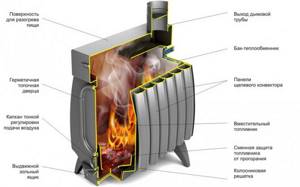
The main difference between long-burning stoves and conventional stoves is the rate of combustion of wood: in a conventional stove, the firewood completely burns out in 3-4 hours , and in “long-term” stoves the combustion process can last up to 10 hours .
The operating principle is based on pyrolysis - a smoldering process during which high-temperature flammable gas is released and collected in a special chamber. It is the combustion of this gas that provides high heat transfer, which does not require the combustion of additional fuel.
Firewood is placed in the furnace firebox, which must be allowed to burn. After which, the air supply is limited using stove dampers, which transforms the combustion process into a smoldering process.
How stove and water heating are combined
Water heating from a stove helps to significantly increase the efficiency of the stove. Although small in size, a stove with a water circuit is capable of heating large areas.
To organize water heating, a heat exchanger is built into the body of the stove, and sometimes it is built into the chimney. Next, pipes are supplied to the heat exchanger, which are subsequently connected to radiators. An expansion tank and pump are installed on the return line. A pump is not necessary, but it helps circulate water in the pipes. Thanks to good circulation, the rooms begin to be heated as soon as the stove is fired. A drainage system is also required to be installed. If the stove will not be used for a long time, for example, in winter, then the water from the system must be drained so that it does not freeze in the pipes and damage them.
Pros and cons of heating equipment based on the principle of pyrolysis
Before installing a long-burning stove, it is necessary to carefully evaluate all the advantages and disadvantages of these devices.
Advantages:
- Cost-effective and higher efficiency compared to conventional wood-burning stoves. Depending on the design of the stove and the type of firewood, the efficiency can be 75-85% .
- Compact dimensions and light weight.
- Easy to install. To install such a furnace, pouring a concrete “cushion” is not required.
- Reduction of harmful emissions resulting from conventional combustion.
- Duration of burning - one “bookmark” can smolder for up to 8-10 hours , continuously warming the room.
- Aesthetic appearance and wide range of models.
- Wide range of fuels. In addition to firewood, these devices can operate on pellets or coal.
Flaws:
- Demanding requirements for sizing. If the chimney is installed incorrectly, the draft force will not reach the required level.
- Constant formation of condensation in the chimney, requiring regular cleaning of the chimney.
- Difficult to use. Adjusting the air supply to achieve the desired combustion intensity requires certain skills; the first time you use it, it will be quite difficult to achieve the desired result.
- During the operation of the furnace, it is necessary to constantly monitor the intensity of the air supply to the firebox.
- Demanding on the quality of the fuel used. When laying undried firewood, the combustion intensity will be less, and a layer of soot will quickly form in the chimney.
What is the difference between a homemade stove and a purchased one?
The pyrolysis process is implemented in different designs, and the choice of manufacturing a stove for a greenhouse is a decisive moment that affects its profitability. So, despite all the attractiveness of heating devices made of bricks (they act as energy accumulators, releasing the heat accumulated during the day at night), it is very difficult to build them with your own hands - it is not for nothing that good stove makers have always been valued in villages.
Stoves with metal bodies are much easier to install. For the pyrolysis version of the “potbelly stove”, any round container made of metal with a thickness of 4–6 mm is usually used - it is easy to ensure smooth operation of the gas distributor. However, homemade craftsmen also adapt available materials for their own purposes - old barrels, gas cylinders, rectangular metal boxes, etc.
Heating stove using sawdust from a barrel
In addition to the shell material, long-burning boilers are classified according to the type of fuel used - liquid or solid.
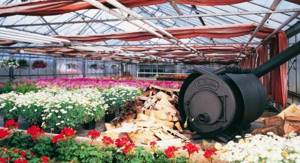
Indeed, there are devices that can even operate on used oil, and their installation is quite simple. But there is a nuance that significantly limits their use, namely, the explosion hazard of such a furnace - the slightest ingress of moisture into the firebox with hot oil will lead to instant ignition.
Waste oil furnace diagram
This is in fact a highly efficient and easy-to-use unit, but from the point of view of manufacturing “on the knee”, its design is complex and requires precise adherence to dimensions and proportions, as well as a large number of welds and the quality of their connection.
And finally, the last of the do-it-yourself long-burning stoves suitable for greenhouses is quite quick, it can be adapted to any fuel, and it burns for a very long time. In addition, there are no strict restrictions on sizes - for assembly you can use what you have on hand.
At first glance, a homemade long-burning stove differs from a purchased one only in price, but in reality everything is more complicated. In factory models, everything is thought out to the smallest detail, so if you do not have experience in this area, it is better not to take risks and purchase a finished product. This way you will protect yourself from possible metal burnout, poor chimney draft and other unpleasant problems that will only complicate the process of operating the finished stove.
Moreover, the parts at hand are not always highly compatible, so you should not count on the fact that different elements of a homemade device will be able to fit together well. However, if you have already prepared the necessary tools and materials, and also have experience in welding, it is worth trying to make a stove yourself, especially since using the diagram of the finished product, there will be no difficulties in inventing a fireplace during testing.
Types of stoves. Design Features
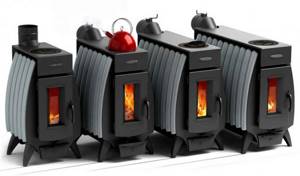
The basic design of a long-burning furnace consists of:
- Cast iron or steel body.
- Two combustion chambers - the primary one, where fuel combustion occurs, and the additional one (afterburning chamber), where gas is burned, generating heat.
- Dampers that regulate the oxygen supply and smoke output.
- Chimney.
Today, there are several types of long-burning furnaces, differing in design features:
- Furnaces with a water circuit.
- Ovens with an additional cooking surface.
- Tube furnaces.
- Long burning fireplaces.
Furnaces also differ in the duration of fuel combustion:
- Models with fast burning - firewood burns out in 3-4 hours .
- Models with average combustion duration - the process will take 6-8 hours .
- Models with long burning - 8-10 hours .
Principle of operation
Furnace structure Professor Butakov. (Click to enlarge)
Butakov stoves are named after their designer, Dr. Butakov, and are manufactured in Novosibirsk.
Their main feature is the optimal ratio of fuel consumption and efficiency: even with a small amount of firewood it is easy to obtain significant heat transfer and warm up the entire room.
The models themselves consist of:
- combustion chambers;
- several external convective tubes;
- chimney;
- passage from below for cold air;
- vertical pipe;
- ash drawer.
Please note: the ash drawer can be pulled out and cleaned even during combustion.
During operation of the furnace, solid fuel burns, and the resulting hot gas heats the convection pipes surrounding the chamber.
Cold air passes through the pipes, which quickly heats up and exits into the room, being replaced by the next “cold” batch. This helps heat up the room quickly without waiting for the oven to heat up. At the same time, the gas formed during combustion again penetrates the combustion chamber, where it again burns out to completely release the heat.
How can you reduce wood consumption?
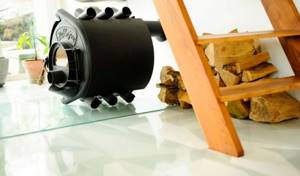
The efficiency of “long-lasting” stoves largely depends on the quality of the fuel and the experience of the stoker. To avoid mistakes when burning, reduce wood consumption and achieve maximum efficiency, there are some useful tips:
- Carefully place the logs on the kindling, leaving a small space between them.
- It is better to pack large logs tightly deep into the firebox and leave the kindling near the door.
- Use only dry firewood. Damp logs will take a very long time to burn and will require more kindling, which will lead to a decrease in efficiency.
- You should not “check” the firebox by constantly opening the door. As soon as the wood is lit, close the door tightly - this will ensure the required level of draft.
How to correctly calculate power
The power of a long-burning stove is easy to calculate. Most manufacturers indicate how much area each oven can heat. For example, the “Fire-battery 5” model is capable of heating a room up to 100 m2 .
When calculating power yourself, keep in mind that 1 kW equals approximately 12 m2 . If the calculation is carried out for several rooms, then the power must be selected for the total area of all the rooms that are supposed to be heated.
Some installation recommendations

Installing a long-burning stove does not cause any particular difficulties. For proper installation, just follow simple rules:
- Use a refractory sheet as a “substrate” for the oven. It is important that the edges of the sheet extend beyond the stove, creating a “mat” in front of the firebox.
- Do not install the structure close to walls. The optimal distance between the stove and the wall is about 20 cm . this will ensure a uniform flow of air and prevent heating of the wall surface.
- To ensure sufficient draft force and prevent blockages in the chimney, its cross-section must be at least 15 cm .
- The chimney must be installed while maintaining access to it. It is best to make a collapsible chimney - this will make cleaning the chimney easier.
- It is best to install the chimney against the movement of gases. This will protect the floor from condensation that settles on the walls of the pipe.
Stove "Bubafonya" from a gas cylinder
Making a long-burning stove with your own hands from a fifty-liter gas cylinder is presented in the video.
The design of the stove is as simple as possible; it consists of only a few parts: a body, a lid, an air distributor and a chimney. For stability, the stove can be placed on legs from the corner. To remove ash from below, you can make an ash pan with a door.
Another video.
Sequencing
- The remaining gas is released from the gas cylinder and washed several times with water.
- Cut off the top of the cylinder. You can use it to make a furnace lid by making a hole with a diameter of 65 mm in the center. The edges of the lid and the furnace body are ground so that the lid fits tightly onto the body.
- In the upper part of the cylinder, a hole with a diameter of 100 mm is made for the chimney and a piece of pipe 30-40 cm long is welded horizontally.
- At the bottom of the cylinder, a cleaning door is made for the ash pan. To do this, cut out a rectangular section of the cylinder body, grind the sections, weld the hinges and install the door on the resulting hole. The door is equipped with a latch.
- The balloon is placed on legs for stability. They can be made from a corner, pipe scraps or a wheel rim. For ease of carrying, rod handles are welded on the sides.
- The most important part of the furnace is the air distributor. It must be heavy enough to effectively press down sawdust and wood chips, withstand the high temperature of the oven, and also have diverging blades. They can be made from corner scraps. The distributor itself is made of thick-walled steel - at least 6 mm. Cut out a circle with a diameter 20-40 mm smaller than the inner diameter of the oven with a hole in the center. A pipe with a diameter of 60 mm and a height greater than the height of the stove is installed in the hole. Air will flow through it to the combustion chamber. The blades are welded at the bottom of the disk.
- You can paint the stove body yourself with paint based on organosilicon compounds, having previously removed scale, rust and dirt from its surface. Any other paint will quickly burn, since the stove heats up to high temperatures during operation.
The temperature of the walls of a gas cylinder stove can heat up to 350 degrees during combustion! To avoid serious burns, use caution!
The homemade sawdust stove “Bubafonya” can be equipped with a water circuit. In this case, it is installed in a permanent place. Typically, this stove is used as a mobile stove: it can be placed in a greenhouse during freezing periods, used to heat a workshop or barn in the winter, or used to heat a garage. Subject to fire safety requirements, Bubafonya is safe and effective.
Rules for safe operation
The safe operation of long-burning stoves is based on several rules:
- Install the stove correctly to prevent smoke and accidental fire.
- Before firing for the first time, be sure to check the tightness of the structure. To do this, it is necessary to put a quick-burning material into the firebox that emits a large amount of smoke. If the seams are not sealed, smoke will leak out of the cracks during combustion.
- Clean the chimney in a timely manner and empty the ash pan of accumulated ash.
- Do not store flammable materials near the oven.
- Always close the firebox door tightly, otherwise carbon monoxide will enter the room.
- Use fuel recommended by the manufacturer. Remember - the use of liquid fuel is unacceptable for all long-burning stoves.
How does a fireplace work?

Heating scheme using a fireplace.
The main difference between a fireplace and a stove is that the fire burns in a niche open from the facade (English fireplace) or in a hearth that does not have an upper vault. In both cases, the smoke rises directly into the chimney and is removed outside. Heating of the room is carried out mainly during the combustion of fuel, because the walls of the fireplace and chimney heat up slightly compared to the stove. To increase the efficiency of the fireplace, a convection chamber is often made around the walls of the firebox, in which air from the room circulates, heating upon contact with the walls and exiting again into the room.
Fuel combustion occurs on the firebox or in a special metal basket, which allows the fuel to burn more evenly, acting as a grate. In some cases, when building a fireplace, an ash pan is laid out and a hole is made in the hearth to install a conventional grate (as in a stove).
The walls, laid out so that in the horizontal section the chamber has the shape of a trapezoid, help improve the heat-reflecting properties of the firebox. The rear sloping wall reflects heat towards the floor of the room. In order to increase the amount of reflected heat, a cast iron plate is mounted on the inclined wall.
To prevent heat from the room from escaping into the pipe, a valve or damper is installed in it.
The efficiency of a fireplace depends on the ratio of its size and the size of the room it heats. If the fireplace is too small, it will not heat the room, and if the fireplace is too large, it will cool the room, removing excess warm air through the pipe, in place of which cold air from the street will enter through the cracks. The ideal ratios would be:
- portal area - 1/50 of the area of the room;
- firebox area - 0.7 portal area;
- chimney clearance is 0.1 of the portal area.
What to look for when choosing
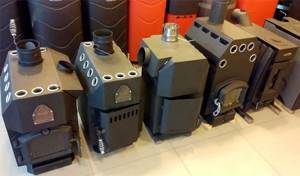
Choosing the right stove will provide you with comfort and coziness in your home, eliminating problems with additional heating. However, in order not to make a mistake in choosing, you should pay attention to the following characteristics of the stove:
- Functional purpose . If you need a stove only for heating, you can purchase a regular “long-lasting” stove, but if you plan to use it as a stove or design element, it is better to opt for fireplace stoves or heating and cooking models.
- Power . The maximum volume of the heated room depends on this indicator.
- Material . Most of these stoves are made of cast iron or steel. Steel models are lighter, and cast iron models are less susceptible to deformation due to exposure to high temperatures.
Required Tools
The process of decorating wooden products has several stages: first, the surface must be properly prepared, then it can be puttied and painted. But depending on the type of materials that will be painted, the technology is somewhat different. The general list of necessary tools for painting includes:
- paint of the desired color and composition;
- brushes;
- putty and primer;
- putty knife;
- “skin” (sandpaper);
- construction hair dryer or cleaning agent.
We will need a hair dryer or a cleaning agent to remove the old paint layer from the product.
You should be very careful, because the temperature of heating the surface with a hairdryer is quite high, which can negatively affect your wooden object. Therefore, if you are going to repair an antique item, it is better to use chemical cleaners.
Stove options that are in high demand. TOP-7 domestic market
The most popular models of long-burning stoves are:
Canadian Buleryan stoves are pioneers of technology
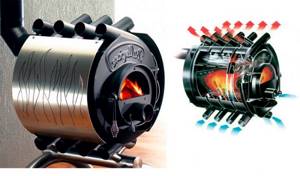
These are products of the Canadian company of the same name, which are widely used in North America and European countries.
The first working prototype was created by Eric Darnell in 1975 . The man noticed the low productivity of a conventional wood stove and improved the design by installing a fire-resistant metal pipe.
The modernized furnace gave excellent results, so Eric, together with two partners, founded the FREE FLOW company and set up mass production.
5 years later , entrepreneur Erhard Knofler, a German by birth, saw such a stove in one of the Canadian bars. The businessman saw great potential in this, so he bought all the rights to the invention and founded the ENERGETEC company and registered the BULLERJAN trademark.
The company operates to this day, with its head office located in the German city of Iserhagen.
Currently, the manufacturer's lineup looks like this:
- Type 00 – power 6 kW , intended for rooms with an area of 100 m2 . Weight: 57 kg .
- Type 01 – power 11 kW , heated area 200 m2 . Product weight – 108 kg .
- Type 02 – capacity 18 kW , heats rooms up to 400 m2 . Structural weight – 130 kg .
- Type 02M is a modernized version, with a power of 24 kW and a heated area of 500 m2 . Stove weight 145 kg .
- Type 03 – power 27 kW , heating area 600 m2 . Weight: 169 kg .
- Type 04 – 35 kW , which allows heating 1,000 m2 of living space. Weight: 215 kg .
It should be noted that the above models differ not only in weight and performance, but also in the diameter of the chimney. This parameter varies between 120-200 mm . An interesting solution is the Aqua stove, complemented by a water circuit.
It is permissible to use all types of fuel with the exception of coal. They are characterized by high efficiency, heating the room in 10-15 minutes . There are both standard “Buleryan” and models with a water circuit or hob.
"Breneran" - a domestic version of an overseas stove

This is the Russian analogue of the previous model. The equipment has been produced since the mid -90s of the last century, but the Breneran trademark was registered only in 2000 .
The equipment is produced using European technologies, therefore, in fact, it is an exact copy of BULLERJAN products.
The manufacturer's lineup is represented by the following stoves:
- AOT-6 – productivity 6 kW , heated area 40 m2 . Weight: 56 kg .
- AOT-11 – power 11 kW , heating area 80 m2 . Weight: 105 kg .
- AOT-14 – power 14 kW , heating area 160 m2 . Weight: 145 kg .
- AOT-16 – productivity 27 kW , useful area 240 m2 . Weight: 205 kg .
- AOT-19 – productivity 35 kW , heating area 400 m2 . Weight: 260 kg .
Products can be equipped with glass doors; models marked AOTV can be connected to a water circuit.
The main disadvantage of the Russian analogue is the insufficient tightness of the smoke fitting, due to which condensation can enter the room. There are models with the ability to connect water heating.
"Professor Butakov" - aesthetic, powerful and reliable models of furnace equipment
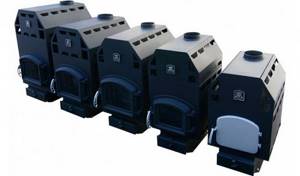
Unlike "Brenerans" they have a more attractive design. They have a large number of air ducts installed in the housing, which allows you to regulate the oxygen supply as accurately as possible.
The main disadvantage of Butakovs is the absence of a condensate collector, which complicates cleaning the chimney.
A patented development by Polytechnic University professor Sergei Efimovich Butakov. Products manufactured under this logo have a state certificate; all models have passed “field” tests in regions with harsh climatic conditions.
Taking into account the main specialty of the inventor, Professor Butakov ovens are presented on the market in the following varieties:
- Student. Product performance is 9 kW , which makes it possible to maintain a comfortable temperature in rooms with a volume of up to 150 m3 . The weight of the stove is about 70 kilograms , the capacity of the firebox is 20 liters .
- Engineer . A power of 15 kW heats interior spaces up to 250 m3 . Product weight 113 kg , firebox capacity: 40 l .
- Assistant professor. The furnace is designed for rooms of 500 m3 , nominal capacity 25 kW . Weight 164 kg , capacity: 200 l .
- Professor . Quite a large product, capable of heating 1,000 m3 of internal space. The stove's output is 40 kW and its weight is 235 kg. Firebox volume: 500 l .
- Academician _ Heats 1,200 cubic meters of internal space, maximum power – 55 kW . Firebox capacity 700 l , weight: 300 kg.
All models are distinguished by a reliable design, create a long-burning effect, and have the ability to be controlled.
Termofor. Traditional source of warmth and comfort
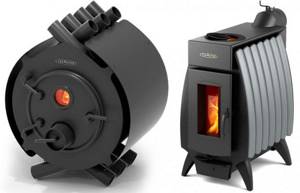
Domestic manufacturer with an amazing history. The development of the company began with the invention of a group of engineers from the Novosibirsk aircraft manufacturing enterprise.
Test samples immediately attracted the attention of the public, so a decision was made about mass production.
In 2000, the Termofor trademark was registered, which belongs to the production company. Currently, the following models are produced under this brand:
- Germa.
- Cinderella.
- Indigirka.
- Normal.
- Fire-battery.
The stoves are designed for heating rooms with a volume of 50-250 m3 , power varies between 4-13 kW . Many products are equipped with doors made of heat-resistant glass and have hobs.
VIRA is one of the simplest and most affordable offers
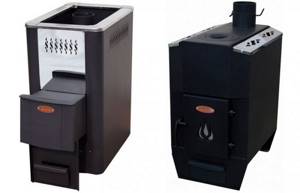
The history of the enterprise began in 2011 , when the Berezovsky Machine-Building Plant launched mass production of long-burning stoves Gori Yasno.
In 2015, a structural unit began operating, which registered the Vira trademark. Currently, the manufacturer's lineup includes about 100 stoves . Let's get acquainted with the most prominent representatives of the series.
- VIKING 150 . The furnace power is 8 kW , the heated volume of the internal space is up to 150 m3 . The weight of the product is 70 kg , there is a hob made of cast iron.
- LEGION 160 . Capacity 8 kW , designed for rooms with a volume of up to 160 m3 . Model weight: 61 kg .
- LEGION 200 . It efficiently heats interior spaces up to 200 cubic meters . Model power 10 kW , weight: 78 kg .
- LEGION 240 . Designed for residential premises of 240 m3 , productivity 12 kW , weight: 75 kg .
All models can be used for cooking and have combustion controls.
Teplodar - reliable and structurally simple models

appeared in 2003 after the reorganization of Narva LLC. Having accumulated experience, the company immediately launches about 20 models of wood-burning stoves into mass production.
The model range is constantly being improved and expanded, the manufacturer becomes a prize-winner at international exhibitions. Currently, the company's products are successfully sold in all regions of Russia and are expanding into the foreign market.
The model range is represented by the following series:
- T
- Pechurka
- Top
- Matrix
- Meteor
- Vertical
The products are designed for heating rooms with an internal volume of 50-300 m3 . All products are maintenance-free and easy to use. The stoves maintain combustion for up to 8 hours and have an attractive modern design.

